Are you a foodie, or do you like to cook and entertain? Well, if you like to cook and are always in need of fresh herbs, this is the right article for you. There is a way you can have fresh herbs all year round and not have to go to the grocery store every time you want to cook with herbs.
What are herbs? Herbs are plants which have an aroma and can also be good for you. Cooking herbs are often added to meat and fish dishes to add a great aromatic flavor to the food. Many times herbs are added together with spices to enhance flavor.
Most of the popular herbs can be found below. Note that there are a wide variety of herbs available and some of the more Oriental dishes require more exotic herbs than are readily available at the grocery store, thus it is beneficial to have an herb garden. Here are some of the most popular herbs and how they are used.
- Rosemary is a wonderful aromatic herb. This herb is often used in Italian dishes from breads to chicken and pizzas. Rosemary can grow rather large, so if you are considering a rosemary plant, you want to get a rather large pot. Wait a month and let it grow before you clip any sprigs from it.
- Oregano is another popular herb, commonly used in Italian, Greek, and other Middle Eastern dishes. There is also a variety known as Greek Oregano, which is popular with many greek dishes. Oregano is commonly used is sauces, meat balls and some condiments.
- Mint is an herb which can grow rather large and many of you might think of mint being great in sweets, which it is, but is often used with meats in many Middle Eastern and Central Asian dishes.
- Parsley is a very common herb used in anything from breakfast sausage to salads. Parsley has small ruffled leaves and has many varieties which include flat leaf parsley and has a wonderful flavor.
- Lemongrass is an herb used in many Oriental dishes, primarily from Indochina, such as Thai, Vietnamese, and Laotian dishes. It has kind of a citrusy taste, similar to the flavor of a lemon, hence its name.
- Cilantro is a wonderful herb used in Mexican, Georgian, and other Middle Eastern and Latino dishes. Cilantro has a very strong aroma and can be an acquired taste. Cilantro seeds are what coriander comes from. Cilantro is also good for cleansing your body from heavy metals.
- Thyme is another herb used in many dishes. Often it is dried and ground, however, it is great for seasoning salads, breakfast sausage, and many other dishes.
- Dill is a rather lacy herb which has a wonderful aroma and is a great herb for pickling and canning. Dill also goes great with fish and can also be used fresh or dried.
Above are some of the most common herbs used by the vast majority of foodies and hobby chefs.
Planning your herb container garden is not too difficult. The key is knowing how much to water and how much sunlight your herbs need. As a rule of thumb, most herbs require part shade to moderate sunlight. Too much sunlight can cause some herbs, such as your parsley and cilantro varieties to wilt.
Watering is also important. Herbs need an amount of water which is just right, not too much and not too little. Herbs can be very sensitive to over and under watering. When you water your herbs, you want to feel the soil with your fingers to see whether the amount of water is just right. If the soil in the pot feels wet, then you gave your herb too much water. If the soil feels moist, then the water is just right. Before watering, it’s a good idea to feel the soil in the pot with your finger. If the soil feels moist, the herbs are fine, if the soil is dry, on the other hand, then they need water.
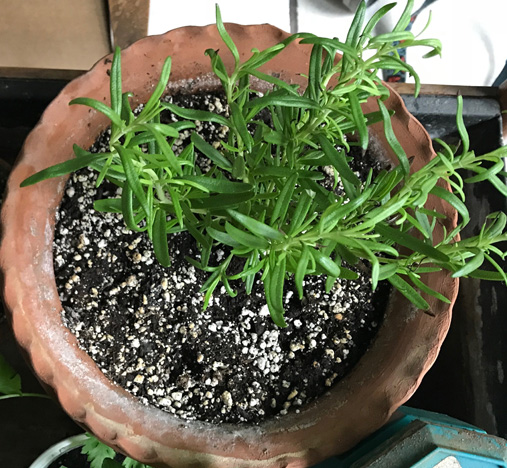
A rosemary plant after being planted into an adequate pot
Planting your herbs is relatively easy. When you go to a place to purchase your herbs, chances are they will come in a small flower pot which will allow them limited root growth, and are not intended for permanent use. You want to transplant those herbs in a larger pot as soon as possible. See the image below to see how the herb looks like when you purchase it.
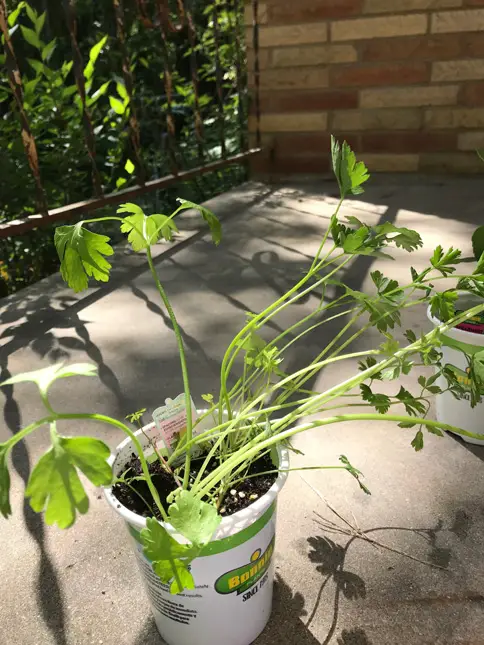
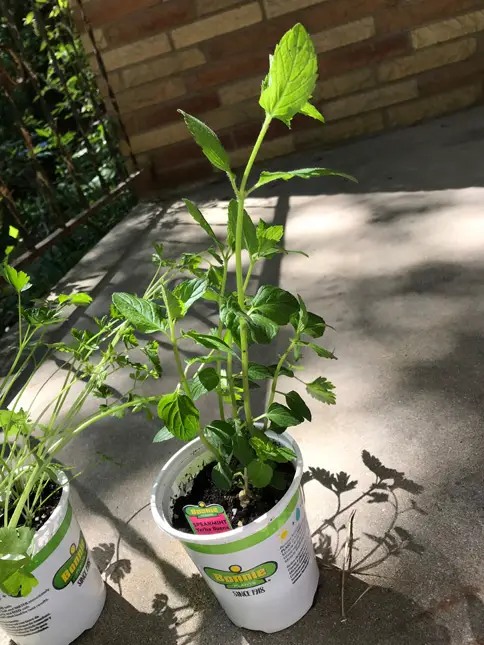
A pot of purchased oregano and flat leaf parsley
Many home and garden places have a limited supply of herbs which you can buy as a seedling. Some of the big box home stores, like Lowe’s, Menard’s, or Home Depot also might have some herbs for you to purchase.
Soil and fertilizer for your potted herbs are also very important. I always stress to go organic. Organic is much better for your plants than the common chemicals, such as MiracleGro. Many manufacturers who bag organic soil for potting plants will have peat, top soil, and natural fertilizer included in the soil. Some of natural organic soils are made from a mixture of manure, bird guano, and bone meal. This provides a healthy nutrient balance for your potted plants.
Transplanting your herbs is rather simple. Find a larger container which provides enough space for your plant to grow its roots and start putting soil until the pot is about 1/3 to half full. Then take the herb out of its pot and at the bottom, loosen its roots. Sometimes, you will notice, when you take the herb out of the pot from the store, you will see more roots than soil. This is why it is important to transplant your herbs into larger pots. If the roots have grown to a larger mass and the plant grows, they will not have enough room to develop and perform their primary function, which is to suck up water and vital nutrients which the plant needs to grow. If this gets neglected, the root system will break down and your herb will die.
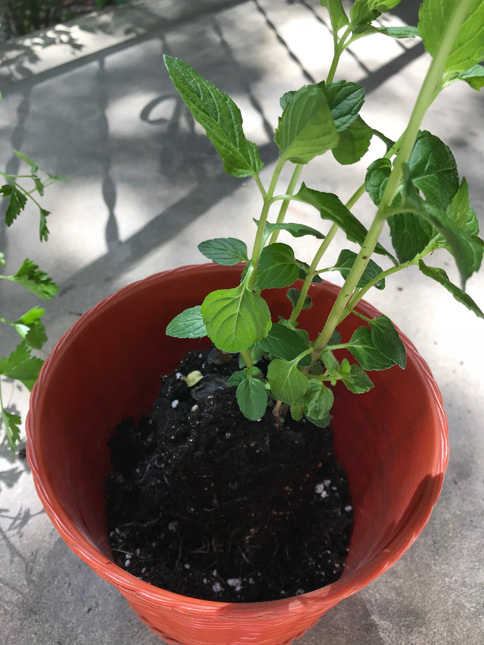
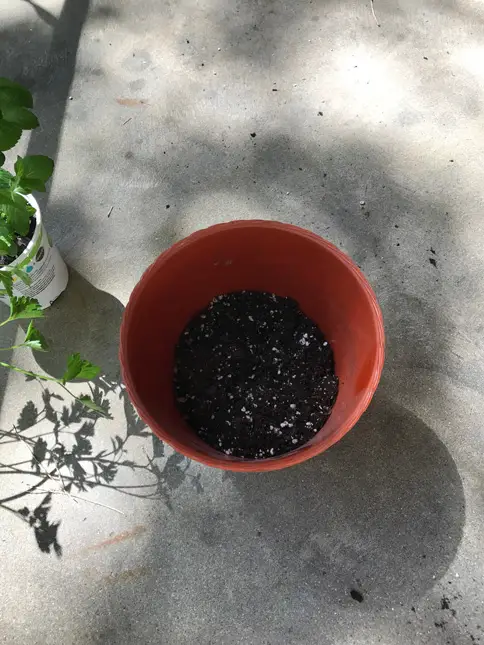
The process of transplanting an herb to a bigger pot
Notice how the pot is first filled to 1/3 to half full. This is very important because you need to make sure that the crown of your herb is at the level of the soil of your pot. The crown is the part of the plant which links the roots to the stems. The crown CANNOT be buried. If the crown is buried under the soil, the plant will get crown rot which will cause the plant to die.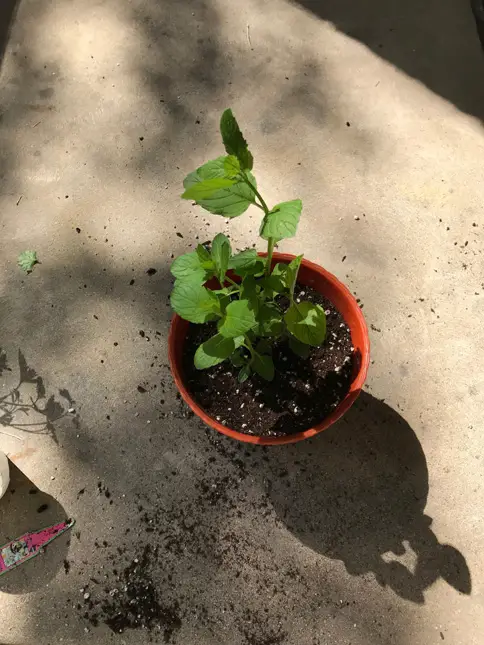
To avoid the crown from being buried, place the herbal plant to see whether it’s high enough. If it is, then you can add more soil. If the plant is not high enough and you feel the crown is too low, put the plant aside and add more soil to the bottom of the pot. If the plant is a bit high, that’s Ok, you can make a mound of soil to keep the crown from being buried.
Care after transplanting is also important. Transplanting any plant whether from a smaller pot to a bigger pot or from a smaller pot to a garden patch can be very stressful for the plant. You will need to water your herbs right after you transplanted them. Then after they have been watered, you want to touch the soil in the pot with your finger to check the moisture. If the soil it dry, it needs water, if moist, the plant has enough water. It’s important not to over water your herbs.
Other container garden ideas for the foodie include different tomato plants, certain peppers, and chives. These plants can also be found in various home and garden stores during the late spring and all summer, the typical growing season in most areas.
Growing herbs from seeds is another way you can grow your herb garden. Seeds, though take longer than buying young plants. The best way to grow seeds is to start in the late winter months, such as late January into February. You have to do this inside, especially in the northern climates, where the winters can be quite cold with hard freezes.
To start with seeds, you want to get flats and trays. What are flats and trays? Well, when you go to a nursery and you buy annuals, such as impatients, begonias, and coleus, they are seedlings which are grown in a tray, which can hold four to six seedlings. The trays are then placed into a container known as a flat. The flat is a rather simple way to store your seedlings. You want to place the seeds into the soil in the trays which are in the flats. You want to keep the flats close to a sunny window or under growth lamps set to a timer. Typically, most herbs will take two months from being a seedling to a plant mature enough to pot.
If you are a foodie and and you like fresh herbs, then you should try growing your herbs. Many fresh herbs are rather expensive when you buy them at the grocery store, and the more exotic the herb, the more expensive it will be. Furthermore, you will not know how fresh the herbs will be in the store. When you grow them yourself, however, you know how fresh they are, you don’t have to worry about them wilting in plastic and you can cut just what you need instead of buying a whole bundle.
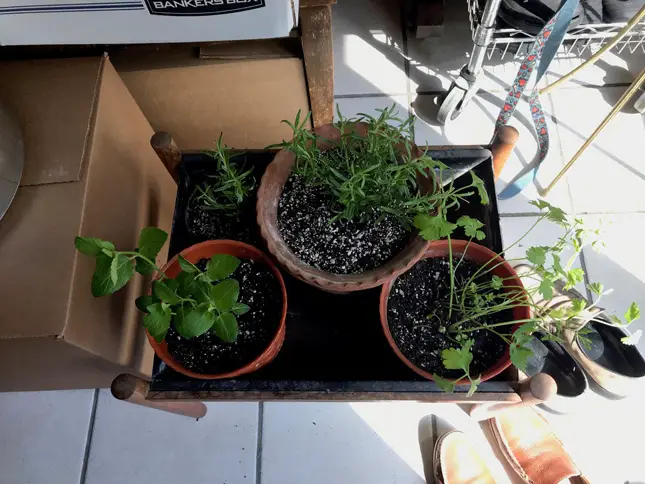
Full container herbal garden for a condo or small apartment













Great information! Starting my own herb garden today!